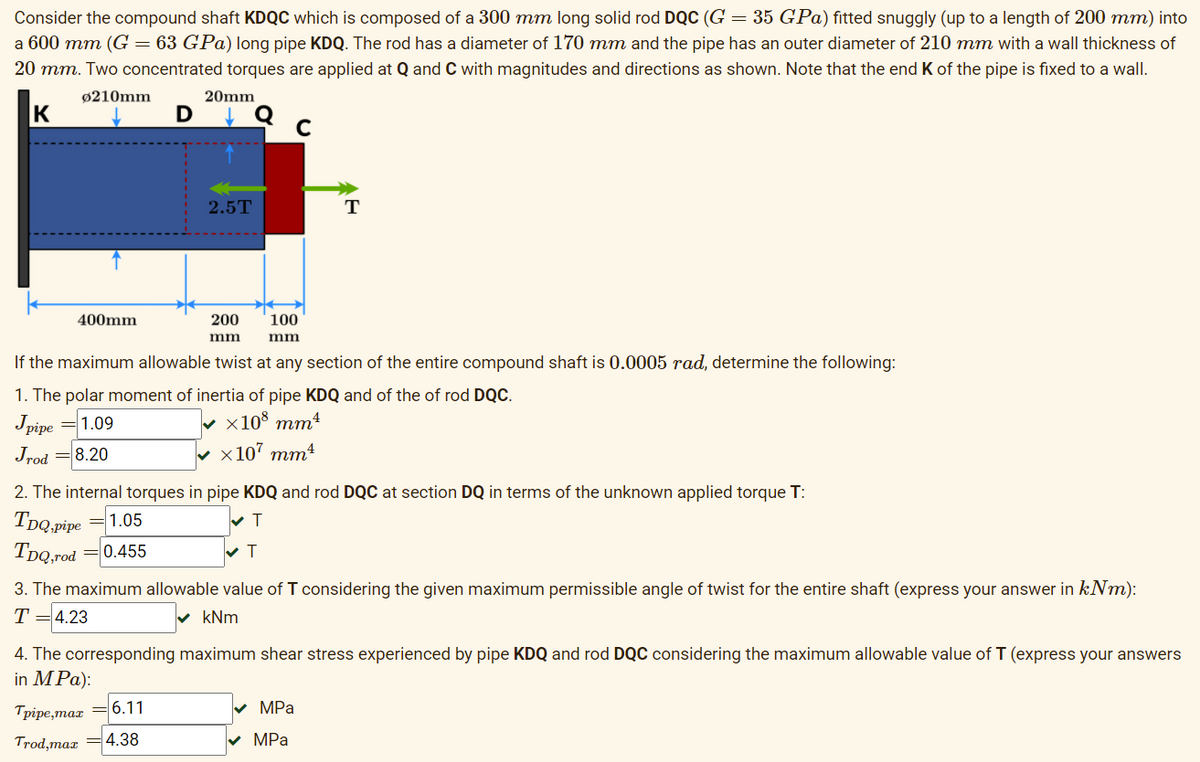Consider the compound shaft KDQC which is composed of a 300 mm long solid rod DQC (G = 35 GPa) fitted snuggly (up to a length of 200 mm) into a 600 mm (G = 63 GPa) long pipe KDQ. The rod has a diameter of 170 mm and the pipe has an outer diameter of 210 mm with a wall thickness of 20 mm. Two concentrated torques are applied at Q and C with magnitudes and directions as shown. Note that the end K of the pipe is fixed to a wall. ø210mm 20mm K C 2.5T T 400mm 200 100 mm mm If the maximum allowable twist at any section of the entire compound shaft is 0.0005 rad, determine the following: 1. The polar moment of inertia of pipe KDQ and of the of rod DQC. Jpipe = 1.09 Jrod = 8.20 v x108 mm4 v x107 mm4 2. The internal torques in pipe KDQ and rod DQC at section DQ in terms of the unknown applied torque T: TpQ.pipe 1.05 TDQ,rod =0.455 3. The maximum allowable value of T considering the given maximum permissible angle of twist for the entire shaft (express your answer in kNm): T =4.23 kNm 4. The corresponding maximum shear stress experienced by pipe KDQ and rod DQC considering the maximum allowable value of I (express your answers in M Pa): Тріре, таz 6.11 MPa Trod,max 4.38 v MPa
Consider the compound shaft KDQC which is composed of a 300 mm long solid rod DQC (G = 35 GPa) fitted snuggly (up to a length of 200 mm) into a 600 mm (G = 63 GPa) long pipe KDQ. The rod has a diameter of 170 mm and the pipe has an outer diameter of 210 mm with a wall thickness of 20 mm. Two concentrated torques are applied at Q and C with magnitudes and directions as shown. Note that the end K of the pipe is fixed to a wall. ø210mm 20mm K C 2.5T T 400mm 200 100 mm mm If the maximum allowable twist at any section of the entire compound shaft is 0.0005 rad, determine the following: 1. The polar moment of inertia of pipe KDQ and of the of rod DQC. Jpipe = 1.09 Jrod = 8.20 v x108 mm4 v x107 mm4 2. The internal torques in pipe KDQ and rod DQC at section DQ in terms of the unknown applied torque T: TpQ.pipe 1.05 TDQ,rod =0.455 3. The maximum allowable value of T considering the given maximum permissible angle of twist for the entire shaft (express your answer in kNm): T =4.23 kNm 4. The corresponding maximum shear stress experienced by pipe KDQ and rod DQC considering the maximum allowable value of I (express your answers in M Pa): Тріре, таz 6.11 MPa Trod,max 4.38 v MPa
Mechanics of Materials (MindTap Course List)
9th Edition
ISBN:9781337093347
Author:Barry J. Goodno, James M. Gere
Publisher:Barry J. Goodno, James M. Gere
Chapter1: Tension, Compression, And Shear
Section: Chapter Questions
Problem 1.3.18P: A stepped shaft ABC consisting of two solid, circular segments is subjected to uniformly distributed...
Related questions
Question
Please explain how 2, 3, and 4 were obtained

Transcribed Image Text:Consider the compound shaft KDQC which is composed of a 300 mm long solid rod DQC (G = 35 GPa) fitted snuggly (up to a length of 200 mm) into
a 600 mm (G = 63 GPa) long pipe KDQ. The rod has a diameter of 170 mm and the pipe has an outer diameter of 210 mm with a wall thickness of
20 mm. Two concentrated torques are applied at Q and C with magnitudes and directions as shown. Note that the end K of the pipe is fixed to a wall.
ø210mm
20mm
K
C
2.5T
T
400mm
200
100
mm
mm
If the maximum allowable twist at any section of the entire compound shaft is 0.0005 rad, determine the following:
1. The polar moment of inertia of pipe KDQ and of the of rod DQC.
Jpipe
v x108 mm4
1.09
Jrod
v x107 mm4
8.20
2. The internal torques in pipe KDQ and rod DQC at section DQ in terms of the unknown applied torque T:
TpQ.pipe
TpQ,rod
1.05
0.455
3. The maximum allowable value of T considering the given maximum permissible angle of twist for the entire shaft (express your answer in kNm):
T = 4.23
v kNm
4. The corresponding maximum shear stress experienced by pipe KDQ and rod DQC considering the maximum allowable value of T (express your answers
in MPa):
Тріре, тал
6.11
v MPa
Trod,max
4.38
v MPa
Expert Solution
This question has been solved!
Explore an expertly crafted, step-by-step solution for a thorough understanding of key concepts.
Step by step
Solved in 2 steps

Knowledge Booster
Learn more about
Need a deep-dive on the concept behind this application? Look no further. Learn more about this topic, mechanical-engineering and related others by exploring similar questions and additional content below.Recommended textbooks for you

Mechanics of Materials (MindTap Course List)
Mechanical Engineering
ISBN:
9781337093347
Author:
Barry J. Goodno, James M. Gere
Publisher:
Cengage Learning

Mechanics of Materials (MindTap Course List)
Mechanical Engineering
ISBN:
9781337093347
Author:
Barry J. Goodno, James M. Gere
Publisher:
Cengage Learning